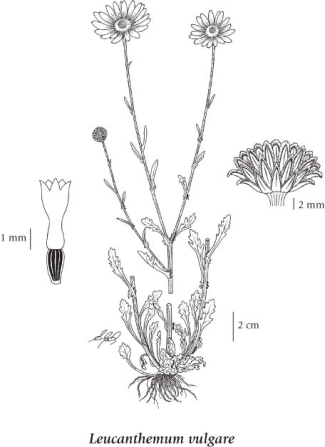Leucanthemum vulgare Lam.
oxeye daisy
Asteraceae (Aster family)
Introduction to Vascular Plants
oxeye daisy
Asteraceae (Aster family)
Introduction to Vascular Plants
Introduction
Ox-eye daisy is a highly abundant introduced European species that is now found across continental North America. It is reported from all US states and all Canadian provinces, exclusive of Nunavut. In BC, it is found in all regions of the province in lowland, steppe and montane zones, from low elevation to a reported maximum of approximately 1800 m in forested sites (see table below for the BEC plot data for this species). Elsewhere it is reported from elevations up to 2000 m (Strother 2010). Ox-eye daisy is an easy to identify perennial rhizomatous member of the daisy family (Asteraceae). Plants are 10-30 (100) cm tall, with often spatulate-shaped basal leaves, and one to several simple or branched stems. Flowers are relatively large white 'daisies' that are solitary on each branch or stem. Each flowerhead can produce up to 200 seeds (Invasive.org 2010). This species can tolerate a range of soil types, and can grow in sun or partial shade. In June, when in flower, this species is very visible along roadsides, in pastures, and in other disturbed sites. In older publications, the scientific name used for this species is Chrysanthemum leucanthemum.
|
Species Information
General:
Perennial herb from a creeping rhizome; stems erect, solitary to several, sparingly branched, usually glabrous, with a sage-like odour, 20-80 cm tall.
Leaves:
Basal leaves alternate, egg-shaped to spoon-shaped, stalked, pinnately lobed or toothed, 4-15 cm long; stem leaves reduced and becoming unstalked and nearly entire upwards.
Flowers:
Heads with ray and disk flowers, solitary at the ends of branches; involucres 7-11 mm tall; involucral bracts narrowly lanceolate, with a narrow, dark-brown submarginal area; ray flowers white, 12-20 mm long; disk flowers yellow.
Fruits:
Achenes cylindric or nearly so, black, 10-ribbed; pappus lacking. vol1_6
Illustration

If more than one illustration is available for a species (e.g., separate illustrations were provided for two subspecies) then links to the separate images will be provided below. Note that individual subspecies or varietal illustrations are not always available.
Illustration Source: The Illustrated Flora of British Columbia
USDA Species Characteristics
Flower Colour:
White
Blooming Period:
Summer
Fruit/Seed characteristics:
Colour: Brown
Present from Summer to Fall
Source: The USDA
Ecology
Ecological Framework for Leucanthemum vulgare
The table below shows the species-specific information calculated from
original data (BEC database) provided by the BC Ministry of Forests and Range.
(Updated August, 2013)
The table below shows the species-specific information calculated from
original data (BEC database) provided by the BC Ministry of Forests and Range.
(Updated August, 2013)
| Site Information |
Value / Class |
||
|
Avg |
Min |
Max |
|
| Elevation
(metres) |
976 | 5 | 1928 |
| Slope
Gradient (%) |
13 | 0 | 68 |
|
Aspect (degrees) |
188 | 0 | 338 |
| Soil
Moisture Regime (SMR) [0 - very xeric; 4 - mesic; 8 - hydric] |
4 | 1 | 7 |
| Modal
Nutrient Regime
Class |
C | ||
| #
of field plots species was recorded in: |
163 | ||
| Modal
BEC Zone Class |
IDF | ||
|
All BEC Zones (# of stations/zone) species was recorded in |
CDF(1), CWH(14), ESSF(12), ICH(28), IDF(46), MS(31), PP(2), SBPS(1), SBS(22) | ||
|
Source:
Klinkenberg 2013
|
|||
Habitat and Range
Mesic to dry roadsides, pastures and waste places in the lowland, steppe and montane zones; common throughout BC S of 56degreeN; introduced from Eurasia.Status Information
Synonyms
Synonyms and Alternate Names:
Chrysanthemum leucanthemum L.
Chrysanthemum leucanthemum var. boecheri B. Boivin
Chrysanthemum leucanthemum var. pinnatifidum Lecoq & Lamotte
Leucanthemum leucanthemum (L.) Rydb.
Leucanthemum vulgare var. pinnatifidum (Lecoq & Lamotte) Moldenke
References
Strother, John L. 2010. Leucanthemum vulgare. Flora North America Online. Available Online.
Invasive.org. 2010. Center for Invasive Species and Ecosystem Health. Available Online.